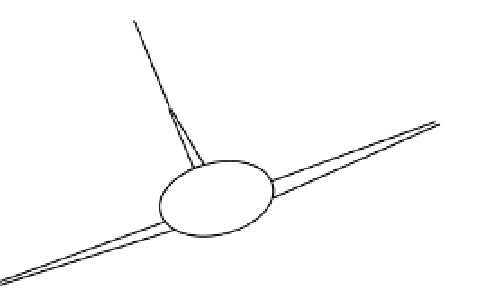Game Development Reference
In-Depth Information
F
L
ψ
ψ
Figure 10-21.
Banking the airplane creates a sideways force component.
When the airplane banks, a sideways component to the lift force causes the airplane to
turn in a circular arc. When the bank angle is brought back to zero, the sideways lift force compo-
nent disappears, and the airplane once again flies in a straight line. The rudder is not used to
turn the airplane but is used during the turn to keep the nose of the airplane pointed in the
direction of the flight path.
If the airplane is performing a level turn (that is, the pitch angle is zero), the radius of the
turn is equal to the square of the velocity divided by the gravitational acceleration multiplied
by the tangent of the bank angle.
v
2
r
=
(10.29)
g
tan
y
One consequence of a plane performing a banking turn is that the stall speed of the airplane
will decrease. For an airplane performing a level turn, the stall speed during the turn,
v
sb
, is
equal to the straight-and-level stall speed,
v
s
, divided by the square root of the cosine of the
bank angle.
v
s
v
=
(10.30)
sb
cos
y
Aircraft Orientation
The lift, thrust, and drag forces that act on an airplane are evaluated relative to the velocity
vector of the airplane. This velocity vector can be pointing in any direction. To determine the
location and velocity of the airplane relative to a fixed point on the ground, the forces normal
and parallel to the velocity vector need to be rotated to the standard Cartesian coordinate
system. We've managed to avoid a detailed discussion of 3-D rotation matrices up to this point
in the topic, but now it's time to bite the bullet and talk about them.
The orientation of an airplane relative to its center of gravity is defined by three angles,
called
pitch
,
roll
, and
yaw
. The three angles represent three coordinate system rotations about
the center of gravity. The three angles are shown schematically in Figure 10-22. We've already
spoken about pitch angle quite a bit in this chapter. Pitch represents a nose-up or nose-down
rotation of the airplane. Yaw is a side-to-side rotation of the nose of the airplane. The roll angle,
also called the bank angle, is an up-or-down rotation of the wing tips.







